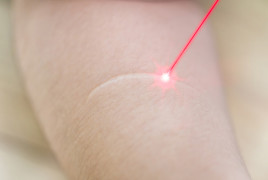Vitiligo: Diagnosis and treatment
How do dermatologists diagnose vitiligo?
If your dermatologist suspects that you have vitiligo, your dermatologist will:
Review your medical history, and may ask specific questions, such as whether anyone in your family has vitiligo
Perform a physical exam, looking carefully at the affected skin
You also may need a blood test to check the health of your thyroid gland. People who have vitiligo often have thyroid disease. A blood test will tell whether your thyroid is healthy. If you have thyroid disease, treatment can successfully control it.
How do dermatologists treat vitiligo?
If you have vitiligo and want to treat it, you should discuss treatment options with a dermatologist. There are many treatment options. The goal of most treatments is to restore lost skin color.
Here are some key facts about treatment options to help you start a conversation with a dermatologist. The type of treatment that is best for you will depend on your preference, overall health, age, and where the vitiligo appears on your body. Some people choose not to treat vitiligo.
No medical treatment (use cosmetics to camouflage lost color)
Medicine applied to the skin
Light treatment
PUVA light therapy
Surgery
Unconventional treatment
Depigmentation
Outcome
It is not possible to predict how a patient will respond to treatment. It is important to keep in mind that no one treatment works for everyone. Results can vary from one part of the body to another. Combining two or more treatments often gives the best results.
Treatment Q&A
Q: Can a child with vitiligo be treated? A: Yes, but some treatments are not appropriate for children. The following may be an option for a child:
Medicine applied to the skin.
PUVA that uses psoralen applied to the skin. PUVA therapy that uses the psoralen pill is usually not recommended until after 12 years of age. Even then, the risk and benefits of this treatment must be carefully weighed.
For children with extensive vitiligo, a dermatologist may recommend narrowband UVB light treatments.
Q: Are researchers looking for more effective treatment? A: Yes. They are studying the genes involved in vitiligo. Researchers believe that by identifying all of the genes involved in vitiligo, they will learn what destroys the cells that give skin its color. With this knowledge, it should be possible to develop better treatments. One of the key goals of this research is to develop a treatment that will permanently stop the skin from losing color.
Related AAD resources
References
Grimes PE, “Vitiligo.” In: Kelly AP and Taylor SC, editors. Dermatology for Skin of Color, China, McGraw-Hill; 2009. p. 317-23.
Halder RM, Taliaferro SJ. “Vitiligo.” In: Wolff K, Goldsmith LA, Katz SI, et al. editors. Fitzpatrick’s Dermatology in General Medicine, 7th ed. United States of America, McGraw Hill Medical; 2008. p.616-21.
Linthorst Homan MW, Spuls PI, de Korte J et al. “The burden of vitiligo: patient characteristics associated with quality of life.” J Am Acad Dermatol 2009; 61: 411-20.
Nicolaidou E, Antoniou C, Stratigos A et al. “Narrowband ultraviolet B phototherapy and 308-nm excimer laser in the treatment of vitiligo: a review.” J Am Acad Dermatol 2009; 60: 470-7.
Ortonne JP, “Vitiligo and other disorders of hypopigmentation.” In: Bolognia JL, Jorizzo JL, Rapini RP, et al. editors. Dermatology, 2nd ed. Spain, Mosby Elsevier; 2008. p. 913-20.
Whitton ME, Ashcroft DM, Gonzalez U. “Therapeutic interventions for vitiligo.” J Am Acad Dermatol 2008; 59: 713-7.
 Think sun protection during Skin Cancer Awareness Month
Think sun protection during Skin Cancer Awareness Month
 How to care for your skin if you have lupus
How to care for your skin if you have lupus
 Practice Safe Sun
Practice Safe Sun
 Sunscreen FAQs
Sunscreen FAQs
 Fade dark spots
Fade dark spots
 Hidradenitis suppurativa
Hidradenitis suppurativa
 Laser hair removal
Laser hair removal
 Scar treatment
Scar treatment
 Botox
Botox
 Kids' camp - Camp Discovery
Kids' camp - Camp Discovery
 Dermatologist-approved lesson plans, activities you can use
Dermatologist-approved lesson plans, activities you can use
 Find a Dermatologist
Find a Dermatologist
 Why choose a board-certified dermatologist?
Why choose a board-certified dermatologist?